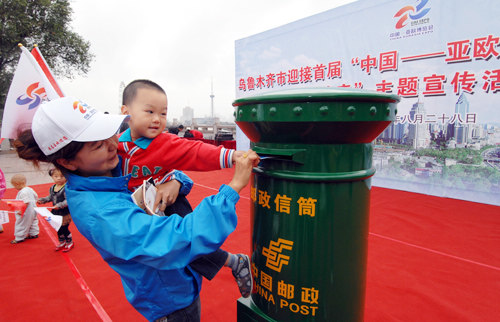|
 |
|
A LONGSTANDING MEMORY: A volunteer helps a boy put a memorial postcard for the first China-Eurasia Expo in a post box in Urumqi, Xinjiang Uygur Autonomous Region, on August 28. The expo was held in the city on September 1-5 (JIANG WENYAO) |
A Special Orbit
China's second lunar orbiter, Chang'e-2, entered the orbit of the second Lagrange Point (L2) on August 25 after a 77-day journey away from its previous orbital path around the Moon. According to China's State Administration of Science, Technology and Industry for National Defense (SASTIND), the satellite is 1.5 million km away from the Earth.
At the point gravity from the Sun and the Earth balance the orbiter so that it remains stationary relative to the Earth, a prime location for the observation of the broader universe. China is the third country to successfully put a spacecraft into an L2 orbit, after the EU and the United States.
Chang'e-2 blasted off on October 1, 2010. Although it was only supposed to remain in space for six months, the SASTIND decided to assign the satellite additional tasks as it still had fuel reserves left after completing its initial tasks.
Chang'e-2 will carry out exploration activities from its L2 orbit over the course of the next 12 months.
Crackdown on Hackers
Chinese hackers, including those who steal information from foreign computers, are facing tougher penalties after a new judicial interpretation came into effect on September 1.
Those who hack into 20 to 100 computers, or steal from 10 to 50 user names and passwords for online-payment or stock accounts, will face at least three-year prison sentences, said the judicial interpretation jointly issued by the China's Supreme People's Court and the Supreme People's Procuratorate. More serious abusers can now be jailed for up to seven years.
The Ministry of Public Security said the number of computer viruses affecting computers in China rose 80 percent this year and claimed eight out of 10 computers with Internet connections were hacked during the past five years.
Cleaning Up
Statistics released by the Ministry of Environmental Protection show China met two major pollution control targets between 2006 and 2010.
The index for sulfur dioxide emissions, the main measure of air pollution, dropped 14.29 percent in 2010 compared with the level observed in 2005, and the index of Chemical Oxygen Demand (COD), a measure of water pollution, decreased 12.45 percent over the same period.
China's 11th Five-Year Plan (2006-10) set out to reduce COD and sulfur dioxide levels by 10 percent over this period.
The ministry attributed these successes to the installation of desulfurizing facilities in thermal power plants and the construction of more sewage treatment plants.
Intangible Heritage
China added 191 items to its newly revised list of state intangible cultural heritage on August 29.
The list of customs, crafts, traditions and skills now includes Arirang, the traditional folk songs of China's ethnic Koreans, the metal forging skills used by ethnic Tibetans and the architectural techniques employed in the wooden structures built by the Tu ethnic group.
After the revision, the number of intangible cultural heritage items under state protection totalled 1,219. China first issued the list in 2006.
The Central Government will allocate special funds for the protection of these listed cultural practices and provide subsidies for major masters and practitioners, said the Ministry of Culture. | 